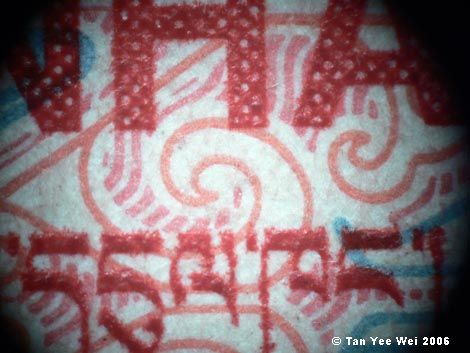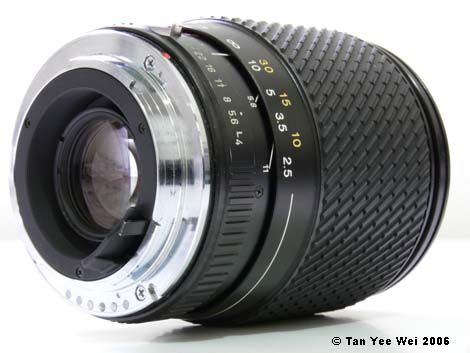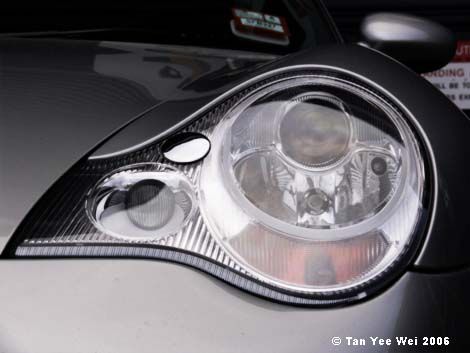Table of contents:An eye-opener of a lunch
不礼貌之客 (no English translation)
Ss. Peter and Paul Ukrainian Catholic Cathedral (photographs)
Cryptonomicon by Neal Stephenson
An eye-opener of a lunchLunch today was actually preset to
Tai Ping Yang (太平洋) in Richmond. It is a popular Chinese restaurant, and apparently it is good. Upon arriving at the venue, its popularity was confirmed- there was a queue at the counter, and the floor was packed. It looked like a scene straight out of Hong Kong, complete with strips of juicy
char siew (叉烧), hunks of crispy
siew yuk (烧肉) and roasted birds hanging at the front window, and strangers sharing tables in a crowded eatery.
Precisely because the restaurant’s popularity was confirmed in such a resounding manner, I could not investigate claims that the food is good.
There was another interesting restaurant in the vicinity, with an extremely attractive name too: Chilli Paradise (辣翻天). The most interesting (read: shocking) dish we ordered was the 水煮鱼 (literally, fish cooked in water).
It came served inelegantly in a huge, thin-walled stainless-steel
bowl basin. But that’s not the point, it’s the edible bits that is the point.

Click here for large size imageSlices of fish and bean sprouts come immersed in the basin-full of liquid. A large quantity of little red dried chillies float on the surface of the fluid. The fluid itself is not soup but…
*drum roll*
chilli oil.
The chilli is remarkable. Unlike the chillies we are accustomed to, this is a completely different
animal plant. It is numbing- bite into a seed or whatever chilli fragment and the tongue takes on a tingling, numbed sensation. For a first timer, it feels extremely weird. However, it is not hot in the usual sense. There is no perspiration nor runny nose, avoiding the unpleasant scene of a wet scalp and dripping nasal fluids.
But that numbing spiciness is a real eye opener. It will rearrange your perception of the universe, assuming the sight of that pot of chillies hasn’t already done so.

Click here for large size image
The dish itself was wonderful. The fish was liberally rubbed with pepper before being immersed in the chilli oil. The bean sprouts gave a nice crunchy contrast to the smooth fish slices. The chilli oil had sesame oil and what feels like some (spring) onions. And it is
not as frightening as it looks, so stop whining.
There was quite a lot of fish and bean sprouts hidden between all that chilli and oil, and at $12, it is worth every cent.
Very, very highly recommended, but only if you dig chillies. Otherwise, stay away.

 不礼貌之客
不礼貌之客今晚,有四个客人到餐馆用餐。
同事Gregory给他们点了菜、送了饮品后,跟我说他们很不礼貌。当时,我还没跟他们接触,就把Gregory的埋怨当为耳边风。
他们差不多吃完了,我去把他们的水杯装满。正倒着时,他们四人一点反应都没有。到完后,没有一个抬起头来,没有一声谢谢,没有一个人把手招一招。果然不礼貌。
我把空水瓶拿回bar去,见老板和Gregory在讨论着这四个客人。老板横着看了他们一眼,问起:“不知他们是什么地方来的?”
Gregory说:“应该是马来西亚吧。”
老板问道:“你又懂?”
“他们讲广东话的。”
“可能是香港嘞?”
我答:“一定不是,香港人的口音不是这样的。”
“新加坡呢?”
这继续了好几分钟,老板似乎希望着这几个人不是来自自己的母国。论了一会,发现他们都很像马来西亚人。这时,老板就开始才他们来自哪个州。
老板笑着说:“一定是马六甲啦!”他指着Gregory,仿佛他罚了严重的罪。
来自马六甲的Gregory反驳:“喂,又关我什么事?”
另一桌吃完了,我把他们的碗碟收回到厨房。手里拿着许许多多的盘,走过这四个客人。只听一声“卖单”,没有招手,没有抬头,没有“excuse me”。我转了身,向他们点头表示明白,便走向厨房去。走过bar时,我跟他们说声“3号要bill。”
搞好了那座得空碗碟后,我说:“真的过分。走过他们就‘卖单’的一声叫单。”
Gregory答:“我们知道。你走了进去他们还喊着卖单卖单。”
我的双眼自动得睁开了一些,半信半疑地“哈。。。?”了一声。
他们终于付了钱(没有小费)而离开(老板向他们说谢谢,他们没反应)。
老板:这些人,真的事。。。
一维:是啦。你刚才跟他们将在煎他们都不回答。
老板:最好是出去跌进水沟里。
老板:都是不要那么衰。踏倒狗粪就好了。大块的狗粪。
一维:又软又臭的。
老板:然后没有发现到,进了车弄得整车都是狗粪。
一维:不然回到家里,印到地毯上。
老板:而且是白色的地毯!
Ss. Peter and Paul Ukrainian Catholic Cathedral (photographs)From a particular entrance to my block of flats I get a clear view of the white dome of the Ss. Peter and Paul Ukrainian Catholic Cathedral, a Ukrainian Catholic cathedral in North Melbourne. When the sun is just behind the dome, it shines through it’s stained glass, and becomes a dramatic beacon.
Yesterday, I took a walk to the cathedral to have a closer look. It’s quite a magnificent structure.

Click here for large size image
Click here for large size image
Click here for large size image
It even has a lightning rod!Cryptonomicon by Neal StephensonSome time ago,
Michelle Chong recommended Cryptonomicon. It is a
brilliant book. Below is a 2-page excerpt:
“Let me just demonstrate,” Waterhouse blurts, and strides out of the room and doesn’t bother looking back. Back in the church, he goes to the console, blows the dandruff off the keys, hits the main power switch. The electric motors come on, somewhere back behind the screen, and the instrument begins to complain and whine. No matter – it can all be drowned out. He scans the rows of stops – he already knows what this organ’s got, because he’s listened and deconstructed. He starts yanking out knobs.
Now Waterhouse is going to demonstrate that Bach can sound good even played on Mr Drkh’s organ, if you choose the right key. Just as Father John and Mr. Drkh are about halfway up the aisle, Waterhouse slams into that old chestnut, Toccata and Fugue in D Minor, except that he’s transposing it into C-sharp minor as he goes along, because (according to a very elegant calculation that just came into his head as he was running up the aisle of the church) it ought to sound good that way when played in Mr Drkh’s mangled tuning system.
The transposition is an awkward business at first and he hits a few wrong notes, but then it comes naturally and he transitions from the toccata into the fugue with tremendous verve and confidence. Gouts of dust and salvos of mouse droppings explode from the pipes as Waterhouse invokes whole ranks that have not been used in decades. Many of these involve big bad loud reed stops that are difficult to tune. Waterhouse senses the pumping machinery straining to keep up with this unprecedented demand for power. The choir loft is suffused with a brilliant glow as the dust flung out of the choked pipes fills the air and catches the light coming through the rose window. Waterhouse muffs a pedal line, spitefully kicks off his terrible shoes and begins to tread the pedals the way he used to in Virginia, with his bare feet, the trajectory of the bass line traced out across the wooden pedals in lines of blood from his exploded blisters. This baby has some nasty thirty-two-foot reed stops in the pedals, real earthshakers, probably put there specifically to irritate the Outer Qwghlmians across the street. None of the people who go to this church have ever heard these stops called into action, but Waterhouse puts them to good use now, firing off power chords like salvos from the mighty guns from the battleship Iowa.
All during the service, during the sermon and the scripture readings and the prayers, when he wasn’t thinking of fucking Mary, he was thinking of how he was going to fix the organ. He was thinking back to the organ he worked on in Virginia, how the stops enabled the flow of air to the different ranks of pipes and how the keys on the keyboard activated all the pipes that were enabled. He has this whole organ visualised in his head now, while he is pounding through to the end of the figure, the top of his skull comes off, the filtered red light pours in, he sees the entire machine in his mind, as if in an exploded draftman’s view. Then it transforms itself into a slightly different machine- an organ that runs on electricity, with ranks of vacuum tubes here, and a grid of relays there. He has the answer, now, to Turning’s question, the question of how to make a pattern of binary data and bury it into the circuitry of a thinking machine so that it can be later disterred.
Waterhouse knows how to make electric memory. He must go write a letter to Alan immediately!
“Excuse me,” he says, and runs from the church. On his way out, he brushes past a small woman who had been standing there gaping at his performance. When he is several blocks away, he realises two things: that he is walking down the street barefoot, and that the young woman was Mary cCmndhd. He will have to circle back later and get his shoes and maybe fuck her. But first things first!
中文文章PhotographsInteresting readsLabels: food, mixed, photography, reviews











































